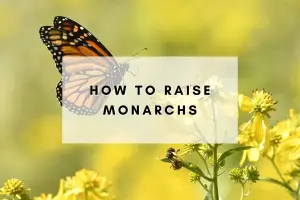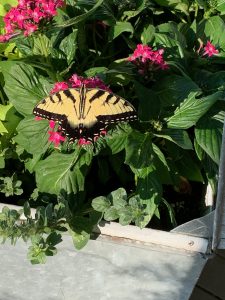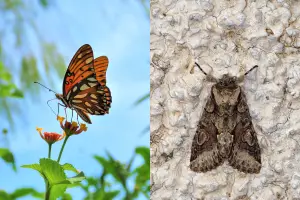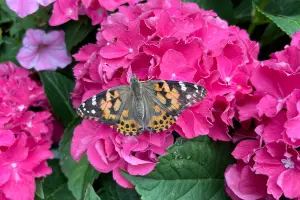Here are answers to some of the most frequently asked questions about butterflies and their life cycles. Have you ever wondered what butterflies actually eat or which colors they see while looking for flowers to land on? Keep reading to learn the answers to those questions and several other FAQS about butterflies.
What do butterflies eat?
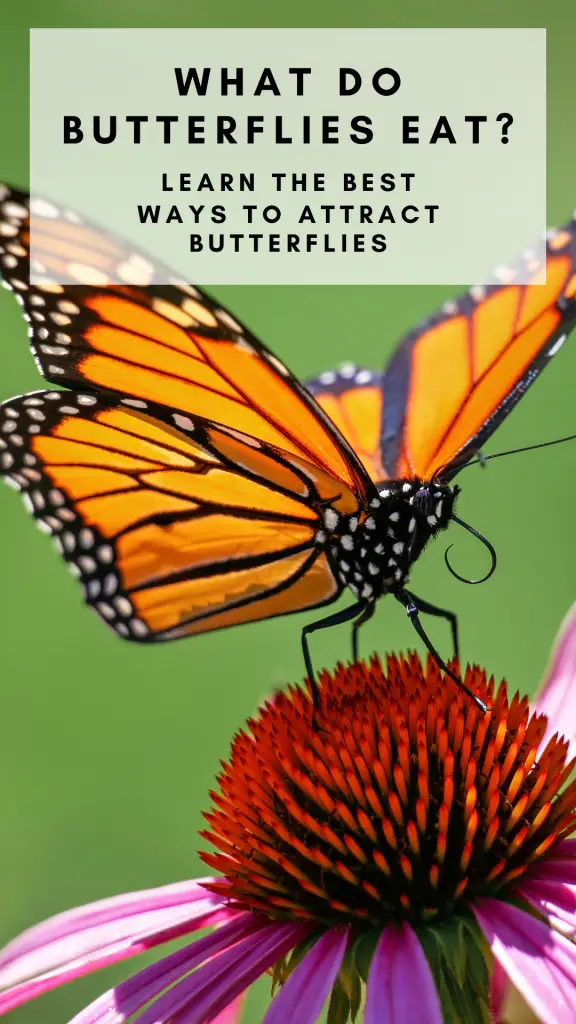
Butterflies primarily feed on nectar, which is the sweet liquid produced by flowers. Nectar provides butterflies with the energy they need for flying and other activities. However, the specific diet of a butterfly can vary depending on its species and life stage. Here’s a breakdown:
- Adult Butterflies: The main food source for adult butterflies is nectar. They have a long, tubular feeding organ called a proboscis, which they use to extract nectar from flowers.
Butterflies are attracted to brightly colored, fragrant flowers that are rich in nectar. Some common nectar plants for butterflies include milkweed, coneflowers, zinnias, butterfly bush, and lantana. - Caterpillars: During their larval stage, butterflies are known as caterpillars. Caterpillars have different feeding preferences based on their species, and each species typically feeds on specific host plants.
Host plants are specific plant species that caterpillars rely on for food and sometimes shelter. For example, monarch butterfly caterpillars feed exclusively on milkweed plants. Swallowtail butterfly caterpillars may feed on plants such as parsley, dill, or citrus trees.
Learn more about the feeding habits of butterflies.
How long do butterflies live?

Unfortunately most butterflies don’t live very long. The lifespan of an adult butterfly is typically somewhere between a few days and a few weeks. However this can very greatly by species. Some butterflies, like the Brimstone (Gonepteryx rhamni) and the Small Tortoiseshell (Aglais urticae) can live for months, sometimes surviving through the entire winter.
What is the life cycle of a butterfly?

The life cycle of a butterfly, known as metamorphosis, is made up of four distinct stages: egg, larva (caterpillar), pupa (chrysalis), and adult. Here’s an overview of each stage:
- Egg: The life cycle begins when a female butterfly lays eggs on or near host plants for that specific species. The eggs are usually small, round, or oval-shaped. Also depending on the species, they may be laid on the top or bottom of the leaf. Typically the egg hatches within a few days or a week.
- Larva (Caterpillar): Once the egg hatches, the larval stage begins. The primary goal of the caterpillar stage is to feed and grow. A caterpillar grows through 5 stages, called instars. The caterpillar molts several times, shedding its outer skin to accommodate its growing body. Each time it sheds its skin, it enters a new instar.
- Pupa (Chrysalis): When the caterpillar has reached its full size, it pupates into its chrysalis, also called a pupa. The caterpillar attaches itself to a surface, such as a leaf or twig, and sheds its skin one final time and forms a protective casing around its body. Inside the chrysalis, the caterpillar’s body breaks down and rearranges itself, until it ecloses (the technical term for hatching from the chrysalis) as a butterfly.
- Adult: The newly emerged butterfly has crumpled wings, and its body is filled with fluid. As it hangs or rests, its wings gradually expand and harden. The fluid is pumped from the abdomen to the wings to help them expand. Once the wings are fully developed and dry, the butterfly is ready to begin its adult life. The primary focus of the adult stage is reproduction and finding food, such as nectar from flowers. Adult butterflies will mate, lay eggs, and continue the life cycle.
The timeline of the life cycle of butterflies varies greatly by species. Many butterflies complete their entire lifecycle in 4-8 weeks, but others may take longer to hatch from eggs or spend more time in the chrysalis.
How do butterflies mate?

Butterflies mate through a process that involves courtship, mating, and fertilization.
Courtship: Male butterflies attract females through elaborate courtship rituals including wing movements, flights, pheromone release, and visual displays. The purpose of these displays is to signal the male’s presence, health, and readiness to mate.
Mating: Once a male butterfly successfully attracts a female, they come together to mate. Butterflies typically mate while perched on a plant or any suitable surface, not while flying. During mating, the male butterfly positions himself on top of the female, aligning their abdomens.
Copulation: The actual act of mating is called copulation. Male butterflies have specialized claspers at the end of their abdomen, which they use to hold onto the female during mating.
Sperm Transfer: During copulation, the male transfers sperm to the female. In butterflies, the sperm is stored by the female for later use in fertilizing eggs. Mating durations can vary among species, ranging from a few seconds to several hours.
Post-Mating Behaviors: After mating, the male butterfly may continue to stay with the female for a short period, ensuring that no other males can mate with her during this critical time. This behavior, known as mate guarding, helps increase the chances of the male’s sperm successfully fertilizing the female’s eggs.
What is the difference between a butterfly and a moth?
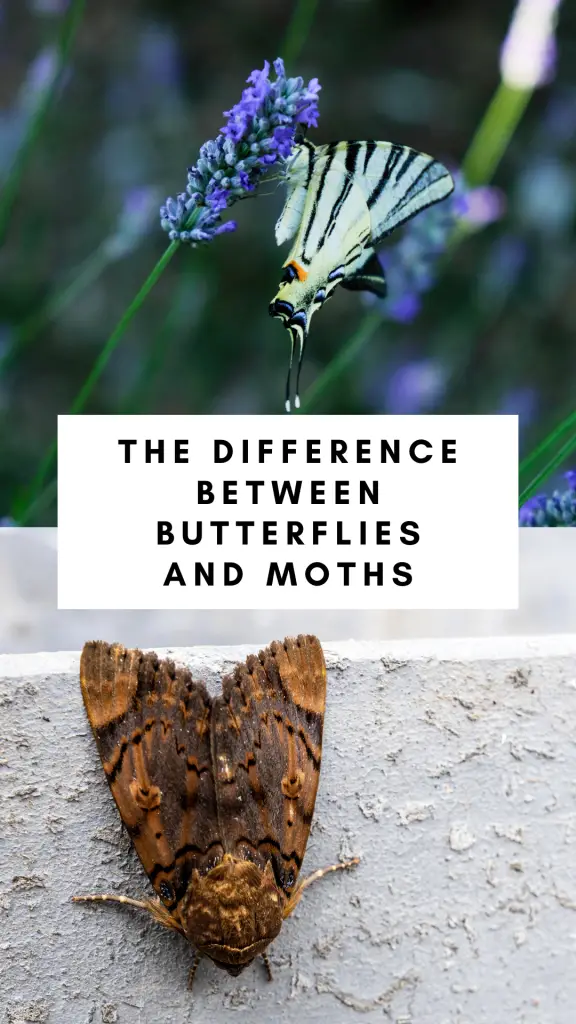
There are several differences that can help you differentiate between a butterfly and a moth. One of the easiest ways to tell is to observe their wing position. When at rest, butterflies typically hold their wings together above their bodies while moths hold their wings flat at their sides.
Learn more about the differences between butterflies and moths.
What are some common butterfly species?
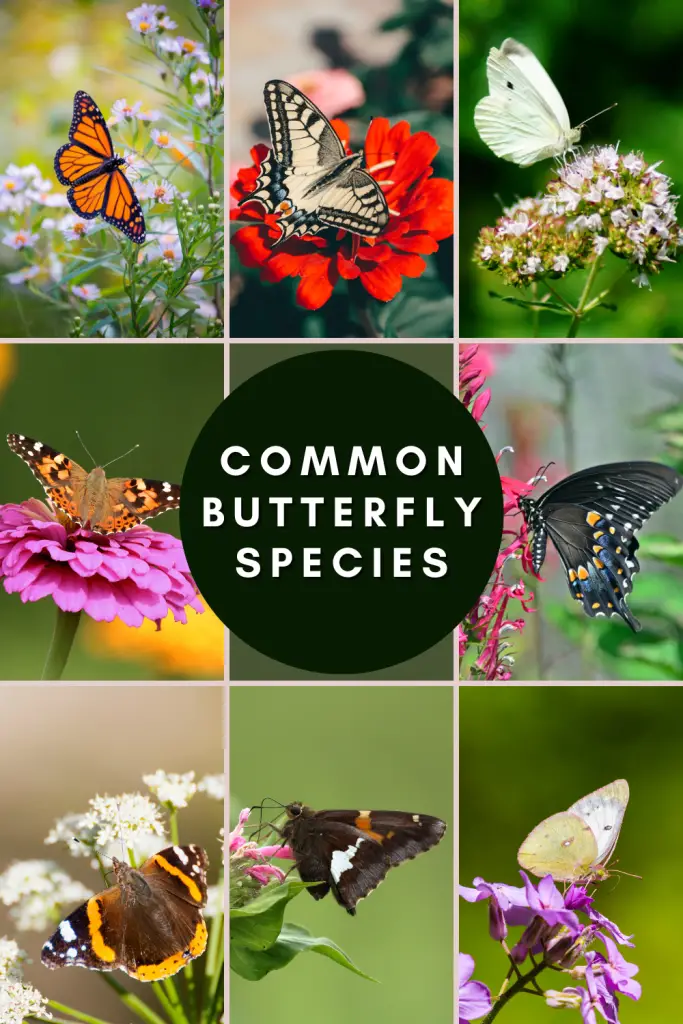
There are estimated to be 750-800 species of butterflies in the United States alone, so “common” butterflies species may vary based on location and local plant life. But here are a few species that most butterfly enthusiasts will recognize.
- Monarch
- Eastern Tiger Swallowtail
- Cabbage White
- Painted Lady
- Eastern Black Swallowtail
- Red Admiral
- Silver-Spotted Skipper
- Clouded Sulphur
Learn more about these each of these common butterflies.
Where do butterflies live?
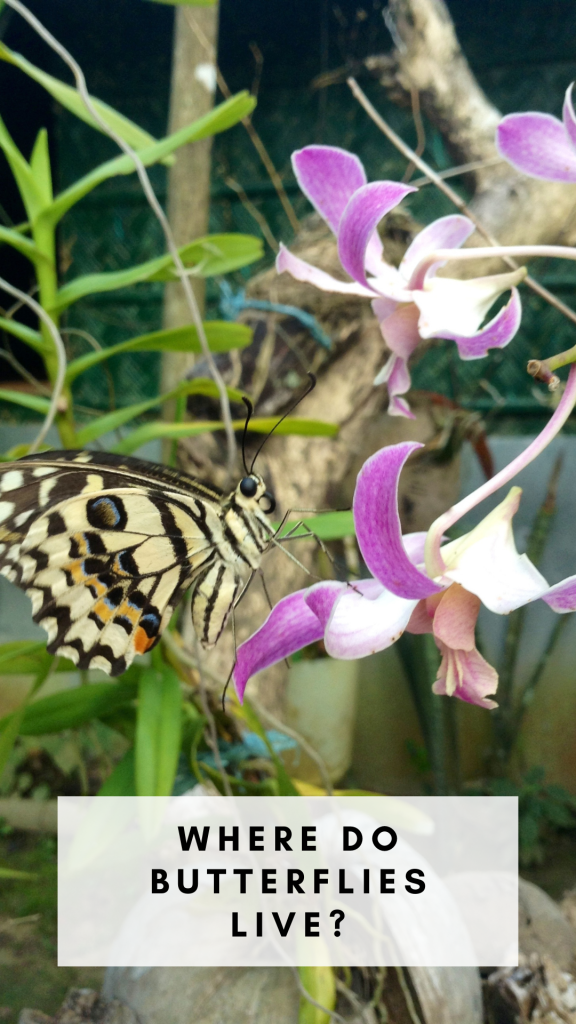
Butterflies can be found in most areas around the world and are extremely common around the United States. Different locations are home to different species of butterflies based on their habitat preferences. Here are some common types of habitats where butterflies are often found:
- Gardens and Parks: Butterflies are frequent visitors to gardens, parks, and other green spaces. These areas often provide abundant nectar-rich flowers for feeding and suitable host plants for breeding. You can create your own butterfly-friendly garden by researching the butterflies in your area and planting their preferred host plants along with a variety of flowering plants native to your area.
- Meadows and Fields: Open meadows and fields are prime habitats for many butterfly species. These expansive areas provide enough space for flying and offer a diverse range of wildflowers that serve as nectar sources for adult butterflies. Meadows also typically host specific host plants that caterpillars feed on.
- Woodlands and Forests: Many butterfly species prefer full sun plants, but some butterfly species thrive in wooded areas and forests. Butterflies that prefer these habitats may rely on specific tree species as host plants for their caterpillars. They often inhabit the edges of forests, where there is a mix of sunlight and shade, allowing for a variety of plant species to grow.
- Wetlands and Marshes: Certain butterfly species are adapted to wetland environments, such as marshes, swamps, and pond edges. These areas provide unique habitats with specialized plant species that act as host plants and nectar sources. Wetlands support a diverse range of butterfly species with their rich vegetation.
- Coastal Areas: Coastal regions can be home to specific butterfly species that have adapted to live in these unique environments. Salt-tolerant plants and coastal dunes provide suitable shelter for certain butterflies, while nearby flowering plants attract them for nectar feeding.
The specific butterfly species you’ll find in each habitat can vary based on the location, climate, and local ecological factors. Creating diverse habitats with a variety of native plants and providing food sources throughout the butterfly season can help attract and support butterflies in your area.
What colors can butterflies see?

Butterflies have fascinating visual systems that allow them to perceive a wide range of colors. Butterflies can even see more colors than humans can!
Ultraviolet Vision: Butterflies have UV-sensitive receptors in their eyes, which enable them to detect ultraviolet light. Many flowers have patterns or markings that are invisible to humans help butterflies find nectar sources and identify suitable flowers for feeding.
Broad Color Perception: Butterflies can see a wide spectrum of colors, including red, green, blue, and various shades in between. They can distinguish subtle color variations, which helps them identify specific flowers, mates, and even potential predators.
Color Preferences: Different butterfly species may have specific color preferences when it comes to selecting nectar sources or host plants for egg-laying. For example, some butterflies are attracted to bright, vibrant colors, while others may prefer more subdued or pastel shades.
Patterns and Contrasts: Butterflies are particularly sensitive to patterns and contrasts. They can perceive color variations and patterns on flowers, leaves, and other. These patterns often serve as visual cues for mating, identifying territory, and recognizing specific plant species.
Camouflage and Mimicry: Butterflies also rely on their color vision for survival strategies like camouflage and mimicry. Some butterfly species have evolved to resemble toxic or distasteful species, using vibrant colors as warning signals to potential predators.
A butterfly’s ability to see a broad spectrum of colors, including ultraviolet light, plays a crucial role in its survival, reproduction, and interactions with its environment.
How do you attract butterflies to your garden?
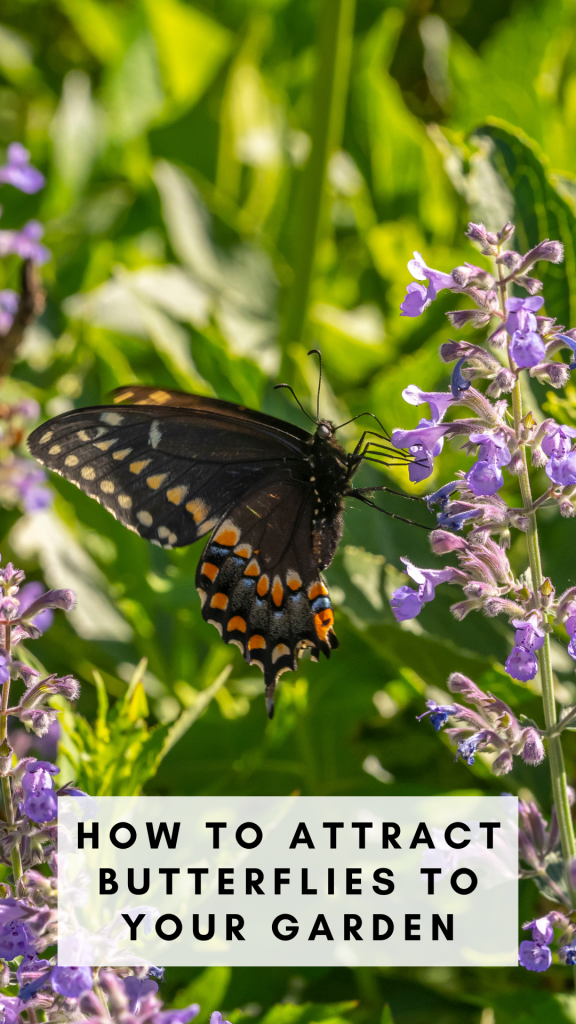
Simply put – you attract butterflies to your garden by planting nectar plants and host plants – the specific plants butterflies lay their eggs on that caterpillars can eat. Host plants vary for each species of butterfly. Some butterfly species can feed on multiple types of plants, and some – like monarchs – will exclusively eat one type of plant.
Butterflies will instinctively find their host plants to lay eggs, and are attracted to vibrant nectar flowers as a food source. Providing both of these things in your garden will attract and benefit all types of pollinators, including butterflies!
Learn how to create a container butterfly garden to attract more butterflies to your yard!
How do butterflies fly?

Butterflies fly through a combination of flapping their wings and gliding. The process of butterfly flight involves several key factors that work together to help them get from place to place. This includes wing shape and movement, scales and flexibility and flight muscles combined with gliding. Learn more about how butterflies fly.
Unlike birds or insects like bees, which have direct muscle attachment to their wings, butterflies rely on the flexibility and unique structure of their wings to achieve flight. Learn more about how butterflies fly.
Did you learn something new from these 10 FAQs about butterflies? Pin it to pinterest!



